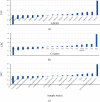PPARD May Play a Protective Role for Major Depressive Disorder
- PMID: 33968145
- PMCID: PMC8081621
- DOI: 10.1155/2021/5518138
PPARD May Play a Protective Role for Major Depressive Disorder
Abstract
Activation of PPARD has been shown to inhibit depressive behaviors and enhances neurogenesis. However, whether PPARD is involved in the pathological development of major depressive disorder (MDD) is largely unknown. To explore the potential connection between PPARD and MDD, we first conducted a literature-based data mining to construct a PPARD-driven MDD regulating network. Then, we tested the PPARD expression changes in MDD patients from 18 independent MDD RNA expression datasets, followed by coexpression analysis, multiple linear regression analysis, and a heterogeneity analysis to study the influential factors for PPARD expression levels. Our results showed that overexpression of PPARD could inhibit inflammatory cytokine signaling pathways and the ROS and glutamate pathways that have been shown to play important roles in the pathological development of MDD. However, PPARD could also activate nitric oxide formation and ceramide synthesis, which was implicated as promoters in the pathogenesis of MDD, indicating the complexity of the relationship between PPARD and MDD. PPARG presented significant within- and between-study variations in the 18 MDD datasets (p value = 0.97), which were significantly associated with the population region (country) and sample source (p < 2.67e - 5). Our results suggested that PPARD could be a potential regulator rather than a biomarker in the pathological development of MDD. This study may add new insights into the understanding of the PPARD-MDD relationship.
Copyright © 2021 Tao Yang et al.
Conflict of interest statement
The authors declare that there is no conflict of interest regarding the publication of this paper.
Figures




Similar articles
-
Increased PPARD Expression May Play a Protective Role in Human Lung Adenocarcinoma and Squamous Cell Carcinoma.PPAR Res. 2022 Mar 15;2022:9414524. doi: 10.1155/2022/9414524. eCollection 2022. PPAR Res. 2022. PMID: 35342393 Free PMC article.
-
PPARD May Play a Protective Role against the Development of Schizophrenia.PPAR Res. 2020 Aug 7;2020:3480412. doi: 10.1155/2020/3480412. eCollection 2020. PPAR Res. 2020. PMID: 32831816 Free PMC article.
-
Explore the Underlying Mechanism Between Atopic Dermatitis and Major Depressive Disorder.Front Genet. 2021 May 28;12:640951. doi: 10.3389/fgene.2021.640951. eCollection 2021. Front Genet. 2021. PMID: 34122503 Free PMC article.
-
Nitric Oxide and Major Depressive Disorder: Pathophysiology and Treatment Implications.Curr Mol Med. 2016;16(2):206-15. doi: 10.2174/1566524016666160126144722. Curr Mol Med. 2016. PMID: 26812915 Review.
-
Role of trophic factors GDNF, IGF-1 and VEGF in major depressive disorder: A comprehensive review of human studies.J Affect Disord. 2016 Jun;197:9-20. doi: 10.1016/j.jad.2016.02.067. Epub 2016 Mar 2. J Affect Disord. 2016. PMID: 26956384 Free PMC article. Review.
Cited by
-
The role of crm-1 in ionizing radiation-induced nervous system dysfunction in Caenorhabditis elegans.Neural Regen Res. 2023 Jun;18(6):1386-1392. doi: 10.4103/1673-5374.357908. Neural Regen Res. 2023. PMID: 36453427 Free PMC article.
-
Anaerobic metabolism promotes breast cancer survival via Histone-3 Lysine-18 lactylation mediating PPARD axis.Cell Death Discov. 2025 Feb 8;11(1):54. doi: 10.1038/s41420-025-02334-x. Cell Death Discov. 2025. PMID: 39922804 Free PMC article.
-
Novel Pharmacological Approaches to the Treatment of Depression.Life (Basel). 2022 Jan 28;12(2):196. doi: 10.3390/life12020196. Life (Basel). 2022. PMID: 35207483 Free PMC article. Review.
References
LinkOut - more resources
Full Text Sources
Other Literature Sources

